16 myths about CRM systems
Having finally decided to start a blog on Habré, we made up a thematic plan for ourselves. After conferring, they included useful questions about various business processes, working with TK, KPI, laws on working with a corporate customer ... And somehow they immediately dismissed the idea of explaining how this software works. But the comments on the posts have forced us to deviate from our plans for exactly one time.
We have long felt this problem: a CRM system has ceased to be a CRM in the classical sense, and this raises a lot of questions and conflicts. It's time to deal with myths and legends about the CRM system and its place in business. Autumn is already here, it's time to tell some details to those who decided to automate the business right now.
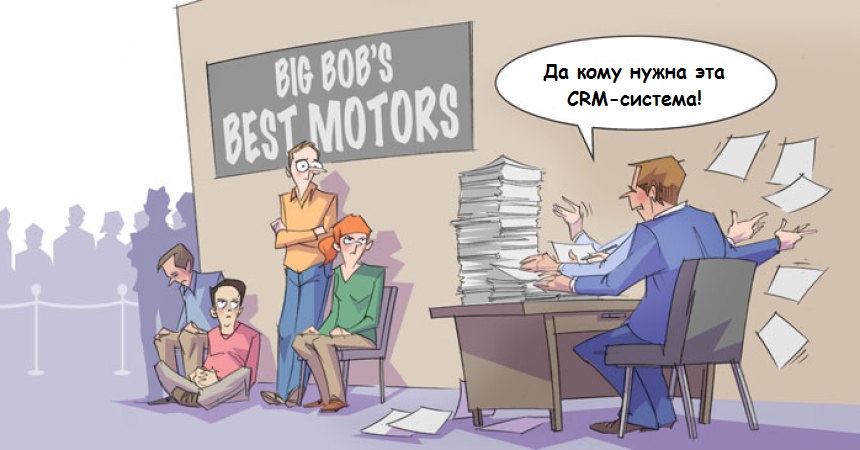
This is where the work on this post began. Many thanks to Louie for the question - he formulated it more accurately than all our customers combined.
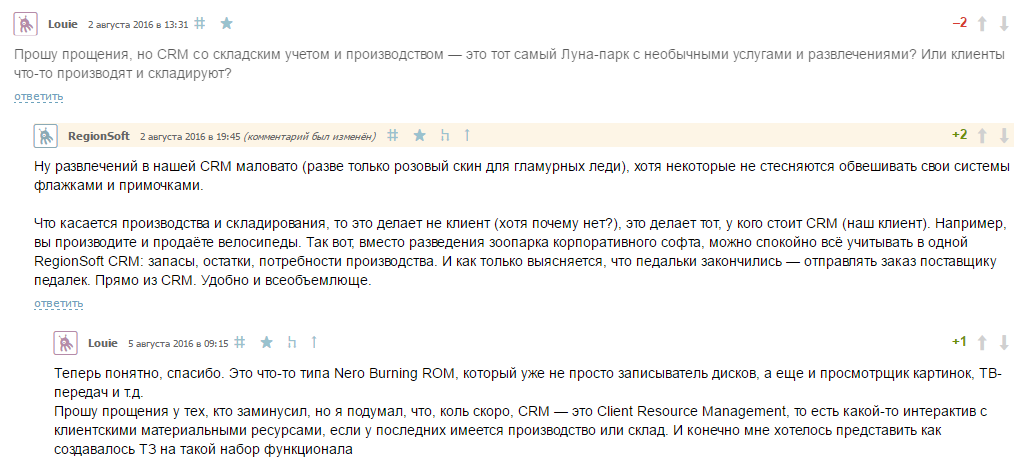
Similar questions are not uncommon, and they have a group of premises.
And yes, a CRM system is a Customer Relationship Management system, a customer relationship management system.
This is not an exhaustive list of reasons, but this information is already enough to generate a huge number of myths and strange statements about CRM systems.
In this section, we have gathered large-scale “claims” to CRM, which can be heard from clients, met at specialized resources and conferences, found in comments, read in critical articles and reviews.
Our foreign colleagues-vendors have a common phraseology “A bad workman blames his tools” (A bad master always has a tool to blame). This is from the category of a bad dancer, whose legs are interfering withsomething , and mugs blaming on the mirror. CRM-system involves three areas: people, processes, technologies. Accordingly, technology solves a maximum of one third. Problems can be inside CRM itself. Or maybe the employee or his manager.

From a technical point of view, CRM is a simple thing: a set of forms, tables, graphs (all this is a graphical interface, GUI), operations and scripts that are responsible for actions with data, a database. The developer’s task is to provide maximum verification of the input data, convenience, storage and quick access to any amount of information through graphs, filters, reports, dashboards. From the user's point of view, for some reason it turns out to be complicated. So, according to the ITIC CRM Deployment Trends Survey (hereinafter referred to as the ITIC poll), 43% recognize complexity as the main obstacle to CRM implementation. Subtle psychology is alien to us, developers, but there is a suspicion that the matter is in the traditional rejection of the new.
But from a business point of view, the problem is that employees do not accept CRM as a tool. No one is afraid to enter customer data in Excel tables, but in CRM the opposite is true, although the tablets are essentially the same. Moreover, the user enters data once - and then all entities are created in relation to this data. Look at the customer card in RegionSoft CRM. Once the manager enters the data into the system, and then absolutely all events related to it are “pulled” into the card: tasks, accounts, files, shipments, customer requests, processes, contracts, mailings, etc., and the fields that are already filled in are used automatically - they do not need to be hammered again. This is the initial logic and essence of CRM: they found a customer’s card, and then they looked at all the events in it, saw the status of the client, looked at the dynamics of relations with him — full automation.
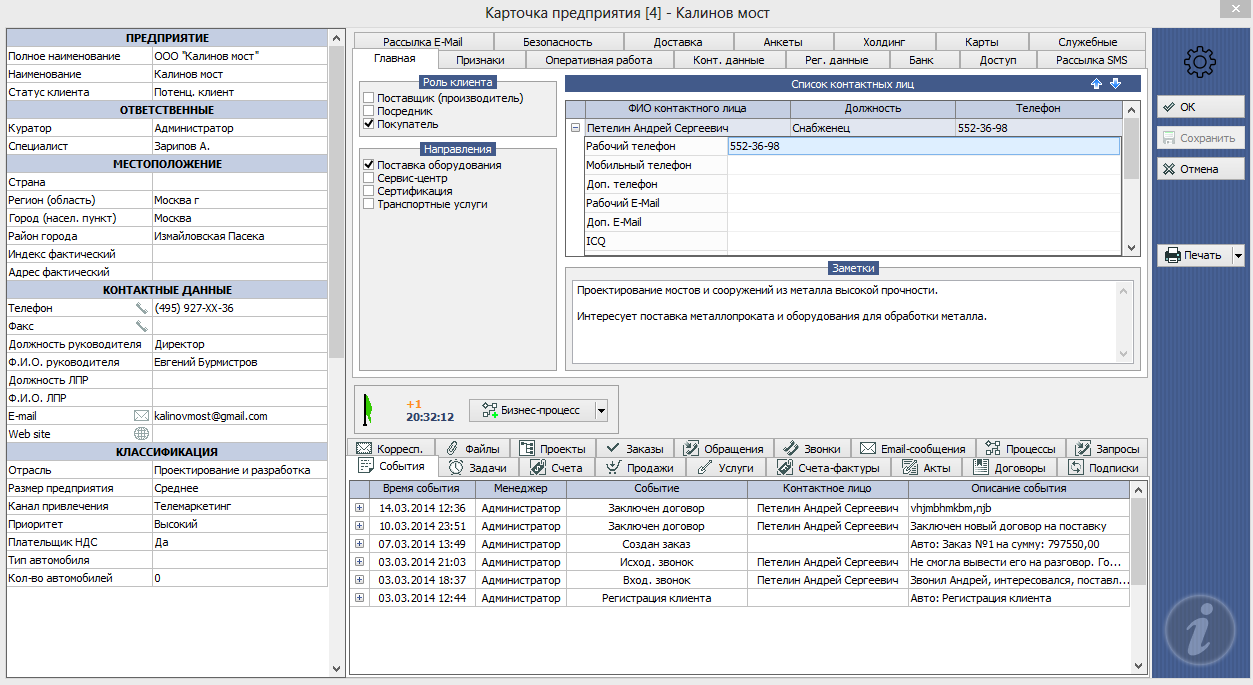
Thus, it all depends on the attitude of people to technology - if they are ready for automation, correctly enter data and realize that CRM significantly accelerates and facilitates their work, it means that relations with the system will develop and the positive effect will not be long in coming.
CRM-system is a technology that automates customer relationships. This means that it is clearly divided into two parts: an IT interior (revision tools, accesses, a database, backups, upgrades) and business logic (work in the system, its configuration). An internal expert, as a rule, is a person from a commercial service who wholeheartedly perceives all the ongoing processes in the company and transfers his knowledge to the organization of work in CRM.
How does a system administrator or programmer see a commercial service? A group of not very advanced users with a zoo of programs, indistinct requirements and 1C in addition. How does a competent sales manager see this? As a set of related business processes and their automation. He knows exactly why CRM should integrate with the warehouse, 1C and the site and how the data works. Therefore, setting up CRM, reports, directories, sales funnel, business processes is his task, and the IT service can help in the implementation of requirements and integration according to the internal technical task.
For example, in our RegionSoft CRM there is everything so that the manager can independently configure his workplace. It is enough for him to go to the “Settings” section, where the user can configure both specific parameters related to the structure of the enterprise, pricing, documents, data, and the parameters of his workplace: displaying tables, setting templates, the appearance of the interface, and so on.
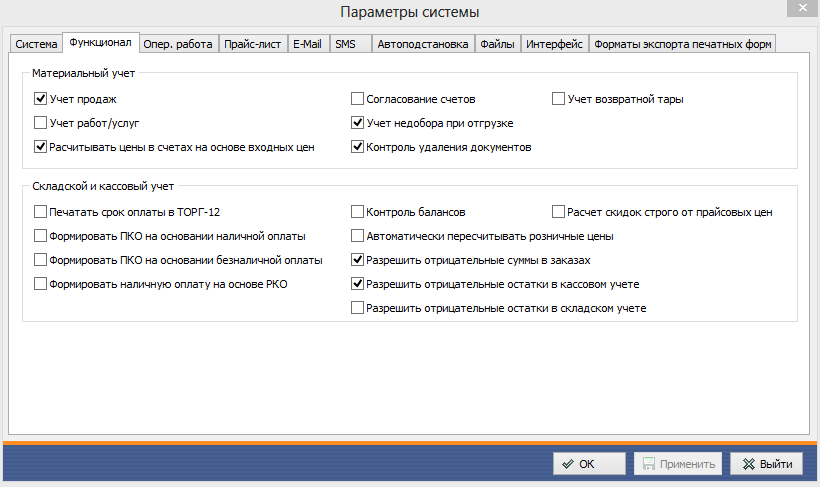
A very common mistake is the implementation of CRM in all departments at once. Yes, today some CRM systems, including RegionSoft CRM, are the same “amusement park” from the commentary: they are able to automate sales, marketing, storage, logistics, cash, human resources and even production management and a support service. This is the result of work on the integration of all business processes in a single corporate information system.
However, the implementation of CRM should be carried out gradually - this does not mean that you first need to automate sales, then marketing, and then the warehouse, this is illogical, because business processes are interconnected. The process of transition to CRM itself should be progressive: from collecting requirements and testing to training and transferring existing data. In fact, introducing CRM, the company revises its business processes, builds unambiguous chains of interactions, and this is not a quick and thoughtful process. The more carefully you approach the implementation process, the more effective the further work will be.
Of course, this is an investment - you invest in the intensification of processes in the company. And the ROI of such investments is often much higher than you expect due to the increase in labor productivity caused by automation. Let me give you a couple of examples that have become painful in almost all companies.
Example 1Coordination of documents. Until now, many companies do not use electronic document management systems and important documents may hang on the executors or in the folder with the general director until the interested manager goes to look for the paper and put it in the hands of all the coordinators. At the same time, finding a document is the best outcome, sometimes they are simply lost and additional time is spent on restoration, and this can be the time of not only the employee, but also the client. In CRM, you can create a chain of approvals as a business process and run it each time a new set of documents is generated - in the end, just open the system to see at what stage of the coordination and to whom the document for this client specifically hung. You save time that can be spent, for example, in negotiations with a new buyer.
Example 2. Calls to the void. The IP telephony zoo of our customers cannot be compared to anything - sometimes it’s even hard to believe that all these providers manage to somehow survive in the market. If CRM is in no way integrated with telephony, managers may not recognize the client in the incoming call and miss out on the potential benefits. Well, or forget to call. In CRM, a customer’s card is raised upon a call, and the manager speaks substantively, based on the profile, relationship history, etc. I'm not talking about forgotten phone calls - when you have a few reminders, it's hard to forget to do your job.
These examples clearly demonstrate how easy it is to solve boring operational issues that take the company time and customers, and simply money. Automation, some time after implementation, greatly simplifies the work, employees work more efficiently, they have more time and fewer misses. CRM is starting to pay off. The exact timing of the return on investment is highly dependent on the size of the company and the cost of implementation.
CRM is expensive- A separate conversation and often not at all a myth. Indeed, there are very expensive CRMs that are nonetheless implemented even in small companies - the honor and praise of their extra to professional salespeople and consultants. So, according to the same ITIC survey, the main obstacle in implementing CRM is the high cost of solutions, 57% of respondents indicated it. Which is not surprising: these same respondents said they were considering Salesforce.com, Sage, Microsoft Dynamics, Sugar CRM, and Oracle / Siebel. In addition to the open source Sugar CRM (more about it later), these are sky-high expensive solutions. Systems are easier to take the last places in popularity - they have worse PR, promotion, weaker consulting. But this does not mean that they are worse, they just have a different cost structure and different pricing.
Very often, when it comes to the high cost of a CRM system, both we and our competitors appeal to compare with the cost of corporate party - just the perfect option. But comparing entertainment with work is strange, so let's go over the bottom line.
For example, the company employs 3 sales people with a salary of 25,000 rubles, their department head with 35,000 and two marketers with 30,000. The company implements RegionSoft CRM in the Professional edition, excluding discounts. The cost of 6 licenses will be released 57,249 rubles one-time, that is, once for the entire project, without further subscription fees. That is, 9,541 p. per person at a time, well, or 795 p. per person per month for a year. A ridiculous amount, given that, in experience, each of them will increase its productivity by at least 15%.
It is also worth noting that there is the concept of CRM cost of ownership. So, in the case of CRM leased according to the SaaS model (as a service — cloud CRM systems usually work this way), the price of ownership is constantly increasing, because you pay rent constantly, every month, like for mobile communications or the Internet. In the case of purchasing an on promise solution, you pay once the entire amount (or by installments), and your payments do not accumulate. Maximum, you can later buy or abandon the upgrade. It is much more profitable. In confirmation of my words, you can look at rental prices and on promise licenses from vendors supplying both types, and you will see that the price for a “server” is higher - that’s how CRM manufacturers “overtake” a client to a cloud more favorable to the supplier itself.
Plus, the cost of licenses is not always equal to the cost of the project: completion, installation, training cost separate money, this must be taken into account, as well as tariff plans for technical support from the vendor.
Fact. Even with us somewhere lies the free RegionSoft CRM 4.7 (current commercial 6.0) per user, without the possibility of network work. Actually, from the previous sentence it is already clear what free CRM is :-) In fact, there are three options for vendors.
These are truly completely free CRM systems that allow you to conduct clients and transactions with various restrictions. By the way, such versions are often used by freelancers for accounting and work planning or by individuals for doing household chores.
Hollywood theme, especially for us. The fact is that our team avoids turning a product, a CRM system, into a set of marketing chips: that’s why users are still greeted by a strict desktop, and not a funny assistant or dashboard, our CRM is not integrated with VK (by the way, this is really for you necessary?) and we do not call our program omnichannel.
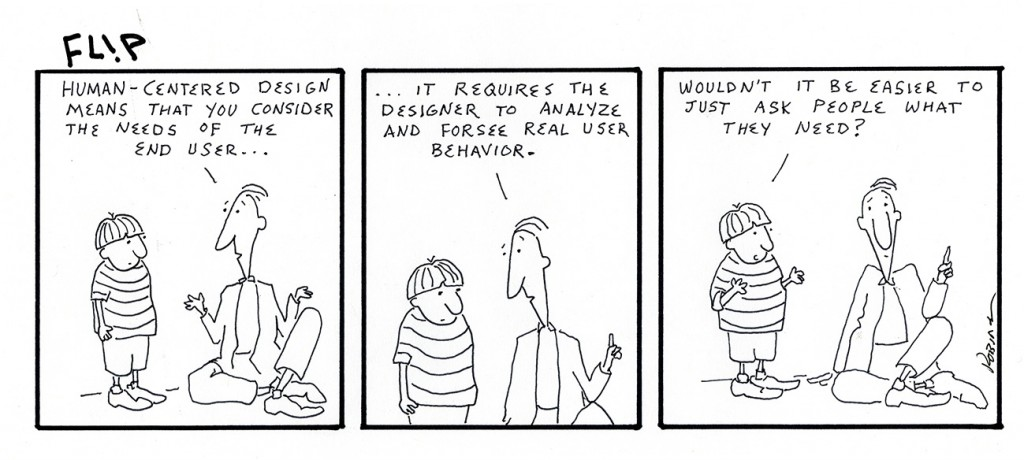
- Human-centered design means that you understand the needs of the end user ... which require the designer to analyze and anticipate the behavior of a real user.
“Isn't it easier to ask people what they need?”
Today, many CRM-systems of our level (small and medium-sized businesses), the interface follows the latest trends in design, often at the expense of ease of use and information content. I will not mention the names in my blog, but, for example, what is the point of welcoming the manager with each month by indicators for the month, especially at the beginning of this month? Enough informative monitor on the side. CRM is a corporate information system, and it should be informative, well-built and simple to the level to which it can be simple.
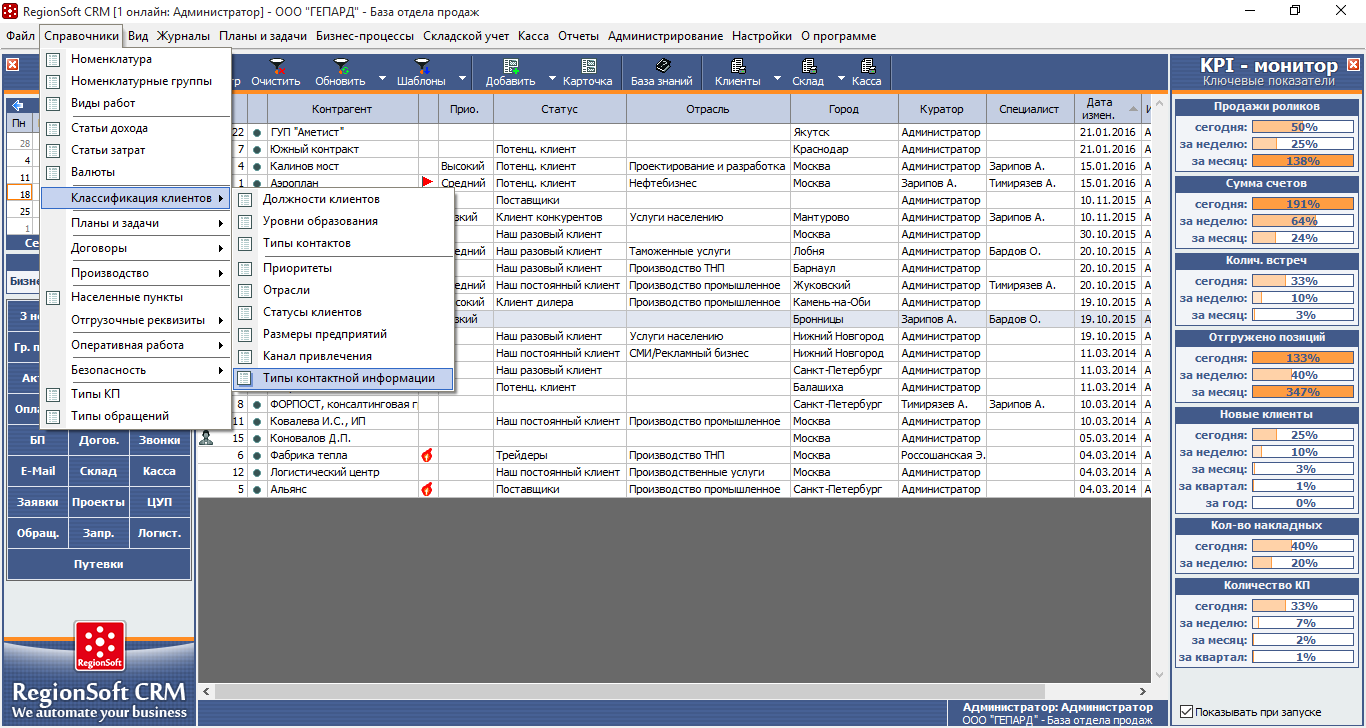
RegionSoft CRM main window (for those who asked, the logo and name change to the logo and name of the CRM user company)
But even if the developer managed to combine the latest design guides with functionality, this does not make the interface friendly, because data entry forms, tables, business processes, etc. - difficult moments of the CRM-system, which should be trained. Because it’s worth going a little deeper, as soon as the user has questions. And training should not be a single act, but a whole session, with practical analysis of operations. So it may be a friendly interface, but not always intuitive when fully using the CRM system.
You can, that's right. Let's draw an analogy with a car. You decided that you absolutely need the exclusive GAZ-21 Volga: you buy a car for 100,000 rubles and start upgrading and tuning it, you buy an engine, components, paint, hire people, rent a garage with a pit, pay for welding, tinning, interior, wheels, wheels, chrome parts ... It will cost you a little for one million rubles, 10 times more expensive than the acquired basis. And then you will still support all this.
The story with CRM on the knee is exactly the same as the story with Volga. And again two options.
Of course, CRM "on the knee" happens, and examples of excellent projects are known, but in the whole mass these are isolated cases. Just because such a project eats away immeasurably forces, money, time and nerves. And he still has to go.
If today and for a long time you only need to record names and phone numbers, the most primitive repository of contact information, close the post and organize an Excel list - this is enough. Wait a while. Do not forget to back up and protect the Excel workbook, otherwise even inept sorting will mix all the data and it will be useless.
Once, when CRM was just in its infancy, especially in Russia, it really was contact managers, notebooks with the ability to select data and set reminders. Today, there are almost none - if only as a module in some corporate software. The goal of modern CRM is to integrate and make customer service, sales, support, logistics, warehouse and much more work smoothly through the accumulation, storage and processing of data in the system. Customer service is not all that is needed today to succeed, and CRM reflects this.
By the way, in many well-known CRM systems, this interaction is based not only on the internal logic of the system, but also on the built-in mechanisms of business processes. When creating the next process, all responsible persons from various departments, dates, reminders and notifications are introduced - thus, in a single chain a whole group of relationships related to a specific process is displayed.
Most surprisingly, some vendors themselves replicate this idea. Yes, there are already working prototypes of salespeople such as online consultants based on machine learning and a stack of IBM Bluemix and Kinect technologies, but it’s still a long way to integration with CRM systems, data analysis and correct interaction. CRM-system does nothing for the user, it is a tool, the same as a PC or MS Word. You do not expect Word to draw up a contract or write a quotation?
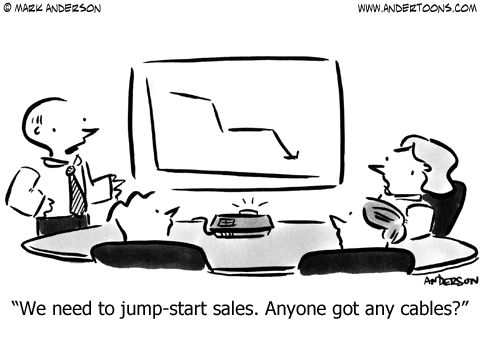 - We must literally charge sales! Does anyone have a suitable cable?
- We must literally charge sales! Does anyone have a suitable cable?
A CRM system is a great way to influence the sales cycle through innovation, automating repetitive processes and routines. Today, CRM additionally helps managers and contractors communicate with each other, honestly and objectively distributing tasks. Through the use of such systems, the business expects fewer surprises and more successful sales. This effect is achieved due to the transparency and accountability of the actions and operations: from building a report to recording a conversation with a client.
It seems to you that it is crazy to compare CRM with Excel? Not at all. Yes, if your CRM system is not compared with a competitor, then it will be compared with Excel. For a long time, it seemed that they were compared with tables in Excel, in which they write contact information and put pluses in front of transactions. Not! One table turned consciousness. This was one Excel sheet of a medium-sized manufacturing company with supplies throughout Russia and the CIS. Not a single macro, or formula - only a huge number of cells with all the information, painted in all possible combinations of colors and fonts, to display the status of work on the client. I think, if this file got to their competitors, they would not be able to figure out all these statuses. The sheet included everything from procurement to warehouses. One man worked with him, since any tiny mistake would destroy this many years of work. And so, basically
I’m disappointing.

Excel for wimps. Here is the perfect CRM system!
This I ran through the basic comparisons that lead customers. In fact, comparing CRM and Excel is really crazy. It is excusable to users, but not to us professionals. We close this question.
Tasty - on the third. This is RegionSoft CRM's favorite myth. We are pleased to receive his daily rebuttal in the form of thanks, but at the first stage of implementation he is more common than others.
About control. According to the survey, 87% of employees believe that CRM is implemented solely for the sake of total supervision of their actions. Of course, a control element is present in the CRM system. For example, in RegionSoft CRMThis is a KPI monitor, action logging, recording conversations with clients, tasks requiring a report. In other CRM systems, this list may differ, but there are always control functions available to the manager. Exactly the same way, and without an automated system, he will ask the manager about the results. Of course, CRM does not track the history of site visits or the installation of pirated software - there are other programs for this. CRM-system is designed for operational control of current activities, it does not carry out any supernatural espionage - all in the framework of the performance of official duties.

About dislike. First of all, the CRM system is not liked ... by the leaders themselves. They are disgusted by the very idea that it is necessary to devote time and attention to changing their working procedures, and begin to build a sales and customer relationship system based on automation. There is nothing strange in the fact that the same attitude is transmitted by the lost one. This is evidenced by the figures for the completeness of using the functionality of the CRM system. According to ITIC CRM Deployment Trends Survey, 52% of respondents said they use more than 51% of the capabilities of CRM and only 18% operate on more than 75% of the functionality. At the same time, 87% of respondents choosing CRM are guided by a set of features and features, 74% look at the price, 71% pay attention to ease of use, 45% turn to a vendor partner, 16% follow the advice of trainers.
It turns out, implemented for the sake of "implement", and the effectiveness of the use is in question precisely because not all capabilities are used. Hence the dislike. Those who actively work in CRM initially, as a rule, quickly evaluate all the advantages and benefits of automation.
About the time. Just count the time it takes to find a contact in Excel, call, enter information, search documents in folders. And then calculate the time it takes to open a customer card, make a call from the CRM interface, and in a couple of clicks pick up all documents, events and tasks. The difference is huge.
In this section of the post, we will briefly answer some common customer objections regarding CRM systems. In fact, there are much more of them, but the rest have a narrower specificity or, conversely, deserve a whole post and this post will be received in the future.
More likely not even a myth, but a common question. Normal CRM can work with several databases - different departments, branches, companies, and anything else. If you need it, just create a new database and enter it under a separate login and password. In RegionSoft CRM, you can safely add databases and select the one you need when entering:
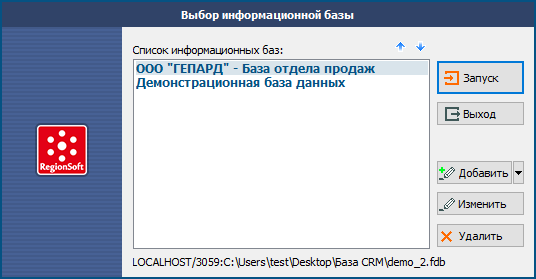
And so the new base is so easily added:
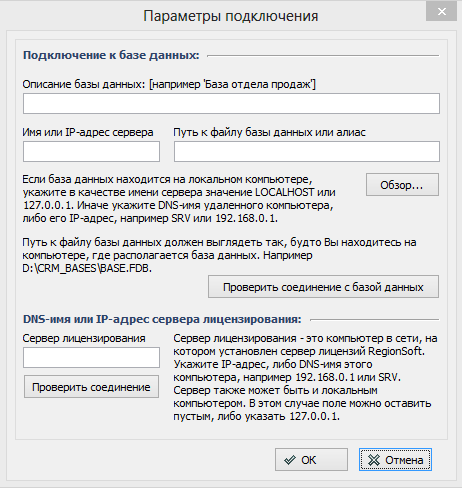
If you have forms of orders or transfers of leads (registration) on the site or you have an online store, it is necessary to integrate, since the site is the most important sales channel. There are CRMs that have built-in connectors for sites (for a fee), there are with their own CMS, there are ones working through an additional smart application (paid). We are the third and work with sites through the RegionSoft Application Server script server .
Yes, today most virtual exchanges have their own CRM or something that resembles it. Basically, these are solutions designed for resale based on customers or for marketing purposes of attracting and retaining. I do not argue that they are convenient and well integrated with telephony, but they do not have a third of the capabilities of classic CRM systems that have been developing over the years. Therefore, we are for the integration of CRM with telephony, the benefit is that almost all the leading vendors can easily cope with this.
Of course, each business is unique and has its own characteristics and features. However, this does not mean that it is worth writing a CRM for each company. Again, let me give you an example with cars - we buy the same makes and models, but we tune to your taste: someone needs increased ground clearance, someone needs sports tires, someone has a bicycle rack, a trailer, a welded step, tinting, armor, etc. .d. The same thing happens in CRM: the client selects the basic solution from the line and then, together with the vendor or the forces of his programmer, finalizes the solution. Although most calmly bypasses the basic functionality.
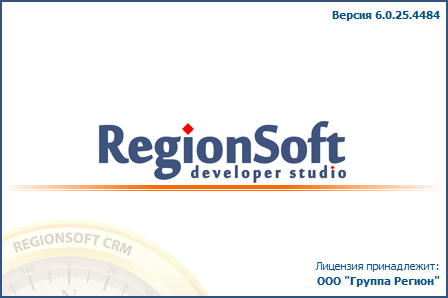
Industry CRM is another specific issue that arises along the way of implementation. Many customers want a CRM system exclusively for advertising agencies, real estate, construction, furniture assembly and so on. And such systems exist, and are quite viable. However, this does not mean at all that they will be suitable or they are more profitable from the point of view of a “turnkey project”. Most often, an industry CRM system arises from the main developer software, modified to order of a particular company - that is, when the vendor found an "investor" and a consultant in the person of the customer. If the project at the exit turns out to be successful and there are no restrictions in the contract, it goes into release and ... becomes an excellent marketing chip, on which they wind up the cost. In fact, far from always the project of one company fits another. Therefore, often either the basic solution is enough,
An industry CRM system can only be built as a solution that is completely redesigned and takes into account the general business logic of the whole industry, and not some former individual customer. For example, this is how we created our RegionSoft CRM Media- CRM system for television and radio holdings. We reworked the logic, included the basic mechanisms that everyone needs on TV and radio: managing software networks, media planning, ratings, loading ads on the air on the fly, on-air references, installation sheets, etc. Accordingly, creating it with one company, we distributed CRM Media to dozens of regional television and radio companies. They got everything they need. We didn’t “embed” reports into the basic CRM system, didn’t add new functionality to existing entities, changing field names — we just created an industry-specific CRM-media for half a year.
The general conclusion that suggests itself from existing myths is that CRM systems are underestimated. Russian business does not yet perceive CRM as part of the IT infrastructure, as application software, as a tool. For many, implementation remains a pending mysterious project. But in vain - competitors are already following an intensive rather than an extensive path of development.
The very idea of CRM as an automation tool is entirely good intentions of saving money, centralizing the activities of companies with an extensive structure, increasing productivity and optimizing existing business processes. And well-intentioned, as you know ... However, it may be time to put an end to mythology and begin to work by the standards of the 21st century.
All December we give discounts on RegionSoft CRM and all software of our own design. From December 1 to December 15 - 15% and cool installment and rental conditions. We do not have -70% and -90%, because we keep an economically reasonable price for licenses, and do not take it from the ceiling.
We conceived an interesting survey , but there were no sociologists in the state. We ask you to answer questions in a simple form - there are only 10 plus 3 for those who are interested in learning more about us. After some time, on the basis of this survey and your feedback, we will build another one, and according to its results we will write a post - so we will receive our data, and not some imported ITIC there.
Take the survey here
Slides, slides: the basis and idea of the KDPV was taken from the site for auto-managers. There are a lot of cool comics.
We have long felt this problem: a CRM system has ceased to be a CRM in the classical sense, and this raises a lot of questions and conflicts. It's time to deal with myths and legends about the CRM system and its place in business. Autumn is already here, it's time to tell some details to those who decided to automate the business right now.

Amusement park with unusual services and entertainment
This is where the work on this post began. Many thanks to Louie for the question - he formulated it more accurately than all our customers combined.

Similar questions are not uncommon, and they have a group of premises.
- The expanded set of features of CRM-systems. Today, these are universal products that cover a significant part of companies' automation needs. CRMs, which have been operating on the market for 10-15 years, have ceased to be sales programs and confidently support ERP.
- The desire to call CRM everything that somehow captures information about customers: collects leads from social networks, automatically sends spam to Viber, works as a notepad to record contacts and transactions, helps employees communicate. All these are CRM systems; as a result, the concept is very blurred.
- The desire of vendors to build marketing is not around the product, but in the product itself, overwhelming it with features that are not related to CRM and real needs.
- A fairly small number of popular resources on the concept of CRM and CRM-systems. Abroad, the number of such sites is in the tens, in Russia this niche is not very busy, and what is busy is not always objective. There are very few platforms for dialogue like Habr.
- The good lies, the bad runs far: as a rule, negative cases of dissatisfied customers are publicly voiced, so from the outside it may seem that introducing CRM is a dangerous thing. Alas, in such complaints everything is blamed on the vendor despite the fact that often it all comes down to errors in the training and perception of software in the company. From the beautiful: "CRM itself does not sell for some reason."
And yes, a CRM system is a Customer Relationship Management system, a customer relationship management system.
This is not an exhaustive list of reasons, but this information is already enough to generate a huge number of myths and strange statements about CRM systems.
Big stories
In this section, we have gathered large-scale “claims” to CRM, which can be heard from clients, met at specialized resources and conferences, found in comments, read in critical articles and reviews.
Technology decides, nothing depends on us, it's developer’s hands are crooked
Our foreign colleagues-vendors have a common phraseology “A bad workman blames his tools” (A bad master always has a tool to blame). This is from the category of a bad dancer, whose legs are interfering with

From a technical point of view, CRM is a simple thing: a set of forms, tables, graphs (all this is a graphical interface, GUI), operations and scripts that are responsible for actions with data, a database. The developer’s task is to provide maximum verification of the input data, convenience, storage and quick access to any amount of information through graphs, filters, reports, dashboards. From the user's point of view, for some reason it turns out to be complicated. So, according to the ITIC CRM Deployment Trends Survey (hereinafter referred to as the ITIC poll), 43% recognize complexity as the main obstacle to CRM implementation. Subtle psychology is alien to us, developers, but there is a suspicion that the matter is in the traditional rejection of the new.
But from a business point of view, the problem is that employees do not accept CRM as a tool. No one is afraid to enter customer data in Excel tables, but in CRM the opposite is true, although the tablets are essentially the same. Moreover, the user enters data once - and then all entities are created in relation to this data. Look at the customer card in RegionSoft CRM. Once the manager enters the data into the system, and then absolutely all events related to it are “pulled” into the card: tasks, accounts, files, shipments, customer requests, processes, contracts, mailings, etc., and the fields that are already filled in are used automatically - they do not need to be hammered again. This is the initial logic and essence of CRM: they found a customer’s card, and then they looked at all the events in it, saw the status of the client, looked at the dynamics of relations with him — full automation.

Thus, it all depends on the attitude of people to technology - if they are ready for automation, correctly enter data and realize that CRM significantly accelerates and facilitates their work, it means that relations with the system will develop and the positive effect will not be long in coming.
The CRM system should be managed by the IT service, and it was hanged on the sales staff!
CRM-system is a technology that automates customer relationships. This means that it is clearly divided into two parts: an IT interior (revision tools, accesses, a database, backups, upgrades) and business logic (work in the system, its configuration). An internal expert, as a rule, is a person from a commercial service who wholeheartedly perceives all the ongoing processes in the company and transfers his knowledge to the organization of work in CRM.
How does a system administrator or programmer see a commercial service? A group of not very advanced users with a zoo of programs, indistinct requirements and 1C in addition. How does a competent sales manager see this? As a set of related business processes and their automation. He knows exactly why CRM should integrate with the warehouse, 1C and the site and how the data works. Therefore, setting up CRM, reports, directories, sales funnel, business processes is his task, and the IT service can help in the implementation of requirements and integration according to the internal technical task.
For example, in our RegionSoft CRM there is everything so that the manager can independently configure his workplace. It is enough for him to go to the “Settings” section, where the user can configure both specific parameters related to the structure of the enterprise, pricing, documents, data, and the parameters of his workplace: displaying tables, setting templates, the appearance of the interface, and so on.

Urgently need to automate the whole company!
A very common mistake is the implementation of CRM in all departments at once. Yes, today some CRM systems, including RegionSoft CRM, are the same “amusement park” from the commentary: they are able to automate sales, marketing, storage, logistics, cash, human resources and even production management and a support service. This is the result of work on the integration of all business processes in a single corporate information system.
However, the implementation of CRM should be carried out gradually - this does not mean that you first need to automate sales, then marketing, and then the warehouse, this is illogical, because business processes are interconnected. The process of transition to CRM itself should be progressive: from collecting requirements and testing to training and transferring existing data. In fact, introducing CRM, the company revises its business processes, builds unambiguous chains of interactions, and this is not a quick and thoughtful process. The more carefully you approach the implementation process, the more effective the further work will be.
CRM is not an investment, and in general a CRM system is expensive
Of course, this is an investment - you invest in the intensification of processes in the company. And the ROI of such investments is often much higher than you expect due to the increase in labor productivity caused by automation. Let me give you a couple of examples that have become painful in almost all companies.
Example 1Coordination of documents. Until now, many companies do not use electronic document management systems and important documents may hang on the executors or in the folder with the general director until the interested manager goes to look for the paper and put it in the hands of all the coordinators. At the same time, finding a document is the best outcome, sometimes they are simply lost and additional time is spent on restoration, and this can be the time of not only the employee, but also the client. In CRM, you can create a chain of approvals as a business process and run it each time a new set of documents is generated - in the end, just open the system to see at what stage of the coordination and to whom the document for this client specifically hung. You save time that can be spent, for example, in negotiations with a new buyer.
Example 2. Calls to the void. The IP telephony zoo of our customers cannot be compared to anything - sometimes it’s even hard to believe that all these providers manage to somehow survive in the market. If CRM is in no way integrated with telephony, managers may not recognize the client in the incoming call and miss out on the potential benefits. Well, or forget to call. In CRM, a customer’s card is raised upon a call, and the manager speaks substantively, based on the profile, relationship history, etc. I'm not talking about forgotten phone calls - when you have a few reminders, it's hard to forget to do your job.
These examples clearly demonstrate how easy it is to solve boring operational issues that take the company time and customers, and simply money. Automation, some time after implementation, greatly simplifies the work, employees work more efficiently, they have more time and fewer misses. CRM is starting to pay off. The exact timing of the return on investment is highly dependent on the size of the company and the cost of implementation.
CRM is expensive- A separate conversation and often not at all a myth. Indeed, there are very expensive CRMs that are nonetheless implemented even in small companies - the honor and praise of their extra to professional salespeople and consultants. So, according to the same ITIC survey, the main obstacle in implementing CRM is the high cost of solutions, 57% of respondents indicated it. Which is not surprising: these same respondents said they were considering Salesforce.com, Sage, Microsoft Dynamics, Sugar CRM, and Oracle / Siebel. In addition to the open source Sugar CRM (more about it later), these are sky-high expensive solutions. Systems are easier to take the last places in popularity - they have worse PR, promotion, weaker consulting. But this does not mean that they are worse, they just have a different cost structure and different pricing.
Very often, when it comes to the high cost of a CRM system, both we and our competitors appeal to compare with the cost of corporate party - just the perfect option. But comparing entertainment with work is strange, so let's go over the bottom line.
For example, the company employs 3 sales people with a salary of 25,000 rubles, their department head with 35,000 and two marketers with 30,000. The company implements RegionSoft CRM in the Professional edition, excluding discounts. The cost of 6 licenses will be released 57,249 rubles one-time, that is, once for the entire project, without further subscription fees. That is, 9,541 p. per person at a time, well, or 795 p. per person per month for a year. A ridiculous amount, given that, in experience, each of them will increase its productivity by at least 15%.
It is also worth noting that there is the concept of CRM cost of ownership. So, in the case of CRM leased according to the SaaS model (as a service — cloud CRM systems usually work this way), the price of ownership is constantly increasing, because you pay rent constantly, every month, like for mobile communications or the Internet. In the case of purchasing an on promise solution, you pay once the entire amount (or by installments), and your payments do not accumulate. Maximum, you can later buy or abandon the upgrade. It is much more profitable. In confirmation of my words, you can look at rental prices and on promise licenses from vendors supplying both types, and you will see that the price for a “server” is higher - that’s how CRM manufacturers “overtake” a client to a cloud more favorable to the supplier itself.
Plus, the cost of licenses is not always equal to the cost of the project: completion, installation, training cost separate money, this must be taken into account, as well as tariff plans for technical support from the vendor.
Free CRMs exist
Fact. Even with us somewhere lies the free RegionSoft CRM 4.7 (current commercial 6.0) per user, without the possibility of network work. Actually, from the previous sentence it is already clear what free CRM is :-) In fact, there are three options for vendors.
- This is an outdated version just to help single entrepreneurs, as in the case of RegionSoft CRM. Well and partly a sales tool to hide.
- This is the current version, laid out instead of the demo version - a matter of taste, we also once did this, or maybe we will. Although to us personally the demo version with demo data seems more interesting to the user.
- This is a multi-user free version - the most insidious marketing ploy. You begin to use the free part of the functionality in unison, rejoice, enter the data, then you no longer have enough options, and it’s time to pay for each step, switching to the paid version and so on and so forth. A common move on the global and Russian CRM markets.
These are truly completely free CRM systems that allow you to conduct clients and transactions with various restrictions. By the way, such versions are often used by freelancers for accounting and work planning or by individuals for doing household chores.
Intuitive friendly interface
Hollywood theme, especially for us. The fact is that our team avoids turning a product, a CRM system, into a set of marketing chips: that’s why users are still greeted by a strict desktop, and not a funny assistant or dashboard, our CRM is not integrated with VK (by the way, this is really for you necessary?) and we do not call our program omnichannel.

- Human-centered design means that you understand the needs of the end user ... which require the designer to analyze and anticipate the behavior of a real user.
“Isn't it easier to ask people what they need?”
Today, many CRM-systems of our level (small and medium-sized businesses), the interface follows the latest trends in design, often at the expense of ease of use and information content. I will not mention the names in my blog, but, for example, what is the point of welcoming the manager with each month by indicators for the month, especially at the beginning of this month? Enough informative monitor on the side. CRM is a corporate information system, and it should be informative, well-built and simple to the level to which it can be simple.

RegionSoft CRM main window (for those who asked, the logo and name change to the logo and name of the CRM user company)
But even if the developer managed to combine the latest design guides with functionality, this does not make the interface friendly, because data entry forms, tables, business processes, etc. - difficult moments of the CRM-system, which should be trained. Because it’s worth going a little deeper, as soon as the user has questions. And training should not be a single act, but a whole session, with practical analysis of operations. So it may be a friendly interface, but not always intuitive when fully using the CRM system.
You can gash CRM on the knee
You can, that's right. Let's draw an analogy with a car. You decided that you absolutely need the exclusive GAZ-21 Volga: you buy a car for 100,000 rubles and start upgrading and tuning it, you buy an engine, components, paint, hire people, rent a garage with a pit, pay for welding, tinning, interior, wheels, wheels, chrome parts ... It will cost you a little for one million rubles, 10 times more expensive than the acquired basis. And then you will still support all this.
The story with CRM on the knee is exactly the same as the story with Volga. And again two options.
- You have a programming department and you write CRM for your company from scratch - without knowing the logic of work, features of integration, working with data, in general, collecting all the cones. Programmers pump their skills, you patiently wait for the result, constantly fix bugs and make new requirements. Then, in the event of the departure of one of the leading developers, you are faced with the problem of software support. The process is long, complicated and not cheap - hardly anyone will do everything for a basic salary, without an IDE and other tools. This approach is justified if you have a very specific business, there are no ready-made solutions, and you need a minimum CRM for accounting customers.
- You take the “free” open source CRM and adapt it to your business. What you need: an employee-programmer with skills in working with the system and the programming language that is used in it, consulting a vendor on the possibilities of improvement, possibly a paid IDE or SDK developer, time. It's minimum. Optional: server or power leased in the data center. Hiring a freelancer does not solve problems - a person must answer to the company, delve into business processes, work with the technical task, and not just create forms with the necessary field names. Fields are not refinement, this is an interface, refinement is CRM logic that works in accordance with the requirements of your business.
Of course, CRM "on the knee" happens, and examples of excellent projects are known, but in the whole mass these are isolated cases. Just because such a project eats away immeasurably forces, money, time and nerves. And he still has to go.
CRM system is to score customers
If today and for a long time you only need to record names and phone numbers, the most primitive repository of contact information, close the post and organize an Excel list - this is enough. Wait a while. Do not forget to back up and protect the Excel workbook, otherwise even inept sorting will mix all the data and it will be useless.
Once, when CRM was just in its infancy, especially in Russia, it really was contact managers, notebooks with the ability to select data and set reminders. Today, there are almost none - if only as a module in some corporate software. The goal of modern CRM is to integrate and make customer service, sales, support, logistics, warehouse and much more work smoothly through the accumulation, storage and processing of data in the system. Customer service is not all that is needed today to succeed, and CRM reflects this.
By the way, in many well-known CRM systems, this interaction is based not only on the internal logic of the system, but also on the built-in mechanisms of business processes. When creating the next process, all responsible persons from various departments, dates, reminders and notifications are introduced - thus, in a single chain a whole group of relationships related to a specific process is displayed.
CRM itself sells everything
Most surprisingly, some vendors themselves replicate this idea. Yes, there are already working prototypes of salespeople such as online consultants based on machine learning and a stack of IBM Bluemix and Kinect technologies, but it’s still a long way to integration with CRM systems, data analysis and correct interaction. CRM-system does nothing for the user, it is a tool, the same as a PC or MS Word. You do not expect Word to draw up a contract or write a quotation?

A CRM system is a great way to influence the sales cycle through innovation, automating repetitive processes and routines. Today, CRM additionally helps managers and contractors communicate with each other, honestly and objectively distributing tasks. Through the use of such systems, the business expects fewer surprises and more successful sales. This effect is achieved due to the transparency and accountability of the actions and operations: from building a report to recording a conversation with a client.
I do not need CRM - I have Excel
It seems to you that it is crazy to compare CRM with Excel? Not at all. Yes, if your CRM system is not compared with a competitor, then it will be compared with Excel. For a long time, it seemed that they were compared with tables in Excel, in which they write contact information and put pluses in front of transactions. Not! One table turned consciousness. This was one Excel sheet of a medium-sized manufacturing company with supplies throughout Russia and the CIS. Not a single macro, or formula - only a huge number of cells with all the information, painted in all possible combinations of colors and fonts, to display the status of work on the client. I think, if this file got to their competitors, they would not be able to figure out all these statuses. The sheet included everything from procurement to warehouses. One man worked with him, since any tiny mistake would destroy this many years of work. And so, basically
I’m disappointing.
- Unlike Excel, in the CRM system all information is collected and stored on the database side and even the most serious errors on the part of the user interface are not able to damage the data, especially if there are backups (you do it, right?).
- The flexibility and versatility of CRM system reports is incomparably steeper than Excel pivot tables.
- CRM does not slow down on big data, but Excel is godless. I will say more, the fact that the table editor hangs tightly, for CRM - generally not big data.
- CRM-system is able to generate events and reminders for them.
- In the CRM system, access rights are delimited at any level, up to private clients, and in Excel you can restrict editing rights, but the data is still visible.
- CRM-system generates documents based on the entered data, supports templates, etc.

Excel for wimps. Here is the perfect CRM system!
This I ran through the basic comparisons that lead customers. In fact, comparing CRM and Excel is really crazy. It is excusable to users, but not to us professionals. We close this question.
It's control and a waste of time; sales people hate CRM
Tasty - on the third. This is RegionSoft CRM's favorite myth. We are pleased to receive his daily rebuttal in the form of thanks, but at the first stage of implementation he is more common than others.
About control. According to the survey, 87% of employees believe that CRM is implemented solely for the sake of total supervision of their actions. Of course, a control element is present in the CRM system. For example, in RegionSoft CRMThis is a KPI monitor, action logging, recording conversations with clients, tasks requiring a report. In other CRM systems, this list may differ, but there are always control functions available to the manager. Exactly the same way, and without an automated system, he will ask the manager about the results. Of course, CRM does not track the history of site visits or the installation of pirated software - there are other programs for this. CRM-system is designed for operational control of current activities, it does not carry out any supernatural espionage - all in the framework of the performance of official duties.

About dislike. First of all, the CRM system is not liked ... by the leaders themselves. They are disgusted by the very idea that it is necessary to devote time and attention to changing their working procedures, and begin to build a sales and customer relationship system based on automation. There is nothing strange in the fact that the same attitude is transmitted by the lost one. This is evidenced by the figures for the completeness of using the functionality of the CRM system. According to ITIC CRM Deployment Trends Survey, 52% of respondents said they use more than 51% of the capabilities of CRM and only 18% operate on more than 75% of the functionality. At the same time, 87% of respondents choosing CRM are guided by a set of features and features, 74% look at the price, 71% pay attention to ease of use, 45% turn to a vendor partner, 16% follow the advice of trainers.
It turns out, implemented for the sake of "implement", and the effectiveness of the use is in question precisely because not all capabilities are used. Hence the dislike. Those who actively work in CRM initially, as a rule, quickly evaluate all the advantages and benefits of automation.
About the time. Just count the time it takes to find a contact in Excel, call, enter information, search documents in folders. And then calculate the time it takes to open a customer card, make a call from the CRM interface, and in a couple of clicks pick up all documents, events and tasks. The difference is huge.
Minor stories
In this section of the post, we will briefly answer some common customer objections regarding CRM systems. In fact, there are much more of them, but the rest have a narrower specificity or, conversely, deserve a whole post and this post will be received in the future.
CRM supports working with one database
More likely not even a myth, but a common question. Normal CRM can work with several databases - different departments, branches, companies, and anything else. If you need it, just create a new database and enter it under a separate login and password. In RegionSoft CRM, you can safely add databases and select the one you need when entering:

And so the new base is so easily added:

CRM and website do not need to integrate
If you have forms of orders or transfers of leads (registration) on the site or you have an online store, it is necessary to integrate, since the site is the most important sales channel. There are CRMs that have built-in connectors for sites (for a fee), there are with their own CMS, there are ones working through an additional smart application (paid). We are the third and work with sites through the RegionSoft Application Server script server .
My telephony has its own CRM
Yes, today most virtual exchanges have their own CRM or something that resembles it. Basically, these are solutions designed for resale based on customers or for marketing purposes of attracting and retaining. I do not argue that they are convenient and well integrated with telephony, but they do not have a third of the capabilities of classic CRM systems that have been developing over the years. Therefore, we are for the integration of CRM with telephony, the benefit is that almost all the leading vendors can easily cope with this.
Every business needs its own CRM
Of course, each business is unique and has its own characteristics and features. However, this does not mean that it is worth writing a CRM for each company. Again, let me give you an example with cars - we buy the same makes and models, but we tune to your taste: someone needs increased ground clearance, someone needs sports tires, someone has a bicycle rack, a trailer, a welded step, tinting, armor, etc. .d. The same thing happens in CRM: the client selects the basic solution from the line and then, together with the vendor or the forces of his programmer, finalizes the solution. Although most calmly bypasses the basic functionality.

Separate CRM for all industries
Industry CRM is another specific issue that arises along the way of implementation. Many customers want a CRM system exclusively for advertising agencies, real estate, construction, furniture assembly and so on. And such systems exist, and are quite viable. However, this does not mean at all that they will be suitable or they are more profitable from the point of view of a “turnkey project”. Most often, an industry CRM system arises from the main developer software, modified to order of a particular company - that is, when the vendor found an "investor" and a consultant in the person of the customer. If the project at the exit turns out to be successful and there are no restrictions in the contract, it goes into release and ... becomes an excellent marketing chip, on which they wind up the cost. In fact, far from always the project of one company fits another. Therefore, often either the basic solution is enough,
An industry CRM system can only be built as a solution that is completely redesigned and takes into account the general business logic of the whole industry, and not some former individual customer. For example, this is how we created our RegionSoft CRM Media- CRM system for television and radio holdings. We reworked the logic, included the basic mechanisms that everyone needs on TV and radio: managing software networks, media planning, ratings, loading ads on the air on the fly, on-air references, installation sheets, etc. Accordingly, creating it with one company, we distributed CRM Media to dozens of regional television and radio companies. They got everything they need. We didn’t “embed” reports into the basic CRM system, didn’t add new functionality to existing entities, changing field names — we just created an industry-specific CRM-media for half a year.
The general conclusion that suggests itself from existing myths is that CRM systems are underestimated. Russian business does not yet perceive CRM as part of the IT infrastructure, as application software, as a tool. For many, implementation remains a pending mysterious project. But in vain - competitors are already following an intensive rather than an extensive path of development.
The very idea of CRM as an automation tool is entirely good intentions of saving money, centralizing the activities of companies with an extensive structure, increasing productivity and optimizing existing business processes. And well-intentioned, as you know ... However, it may be time to put an end to mythology and begin to work by the standards of the 21st century.
All December we give discounts on RegionSoft CRM and all software of our own design. From December 1 to December 15 - 15% and cool installment and rental conditions. We do not have -70% and -90%, because we keep an economically reasonable price for licenses, and do not take it from the ceiling.
We conceived an interesting survey , but there were no sociologists in the state. We ask you to answer questions in a simple form - there are only 10 plus 3 for those who are interested in learning more about us. After some time, on the basis of this survey and your feedback, we will build another one, and according to its results we will write a post - so we will receive our data, and not some imported ITIC there.
Take the survey here
Slides, slides: the basis and idea of the KDPV was taken from the site for auto-managers. There are a lot of cool comics.
